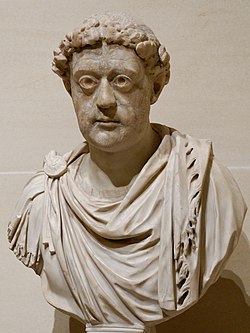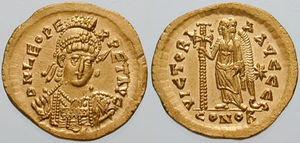Leo I (emperor)
| Leo I | |
|---|---|
 Portrait of Leo at the Louvre | |
| Roman emperor of the East | |
| Reign | 7 February 457 – 18 January 474 |
| Predecessor | Marcian |
| Successor | Leo II |
| Western emperors | Majorian (457–461) Libius Severus (461–465) Anthemius (467–472) Olybrius (472) Glycerius (473–474) |
| Born | c. 401 Dacia Aureliana |
| Died | 18 January 474 (aged 73)[1] Constantinople |
| Spouse | Verina |
| Issue | Ariadne, Leontia, unnamed son |
| Dynasty | Leonid |
Leo the Great | |
|---|---|
 16th cent. Russian Icon depecting St. Leo's enshrinement of the Robe of the Theotokos in Sts. Peter and Mark church, Blachernae | |
| Holy and Right-Believing Emperor of the Romans | |
| Venerated in | Eastern Orthodoxy |
| Feast | 20 January |
| Attributes | Imperial attire |
Leo I (Greek: Λέων, translit. Léōn; c. 401 – 18 January 474) was Eastern Roman emperor from 457 to 474. He was a native of Dacia Aureliana near historic Thrace. Sometimes, he is called Leo the Great (Greek: ὁ Μέγας, translit. ho Mégas), probably to distinguish him from his young grandson and co-augustus Leo II (Greek: ὁ Μικρός, translit. ho Mikrós, lit. "the Small").[2]
Ruling the Eastern Empire for nearly 20 years, Leo proved to be a capable ruler. He oversaw many ambitious political and military plans, aimed mostly at aiding the faltering Western Roman Empire and recovering its former territories. He is notable for being the first Eastern Emperor to legislate in Koine Greek rather than Late Latin.[3] He is commemorated as a saint in the Orthodox Church, with his feast day on 20 January.[4][5]
Reign[]

He was born in Thracia or in Dacia Aureliana province in the year 401 to a Thraco-Roman family.[6] His Dacian origin[7] is mentioned by Candidus Isaurus,[8][9] while John Malalas believes that he was of Bessian stock.[8][10] He served in the Roman army, rising to the rank of comes rei militaris. Leo was the last of a series of emperors placed on the throne by Aspar, the Alan serving as commander-in-chief of the army, who thought Leo would be an easy puppet ruler. Instead, Leo became more and more independent from Aspar, causing tension that would culminate in the assassination of the latter.[clarification needed]
Leo's coronation as emperor on 7 February 457,[11][12] was the first to add a Christian element to the traditional Roman procedure: coronation performed by the Patriarch of Constantinople[13] and thus symbolized the transformation of Roman Imperial Traditions into Byzantium and Christians ones. This medieval Byzantine coronation ritual was later imitated by courts all over Europe.[14]
Leo I made an alliance with the Isaurians[clarification needed] and was thus able to eliminate Aspar. The price of the alliance was the marriage of Leo's daughter to Tarasicodissa, leader of the Isaurians, who, as Zeno, became emperor in 474. In 469, Aspar attempted to assassinate Zeno[15] and very nearly succeeded. Finally, in 471, Aspar's son Ardabur was implicated in a plot against Leo but was killed by palace eunuchs acting on Leo's orders.[16]

Leo sometimes overestimated his abilities and made mistakes that threatened the internal order of the Empire. The Balkans were ravaged by the Ostrogoths, after a disagreement between the Emperor and the young chief Theodoric the Great, who had been raised at Leo's court in Constantinople, where he was steeped in Roman government and military tactics. There were also some raids by the Huns. However, these attackers were unable to take Constantinople thanks to the walls, which had been rebuilt and reinforced in the reign of Theodosius II and against which they possessed no suitable siege engines.[clarification needed]
Leo's reign was also noteworthy for his influence in the Western Roman Empire, marked by his appointment of Anthemius as Western Roman emperor in 467. He attempted to build on this political achievement with an expedition against the Vandals in 468, which was defeated due to the arrogance of Leo's brother-in-law Basiliscus. This disaster drained the Empire of men and money. Procopius estimated the costs of the expedition to be 130,000 pounds of gold; John the Lydian estimated the costs to be 65,000 pounds of gold and 750,000 pounds of silver.[17] The expedition consisted of 1,113 ships carrying 100,000 men; 600 of these ships were lost during the expedition. After this defeat, the Vandals raided Greek coasts until a costly peace agreement was signed between Leo and Genseric. Leo became very unpopular in his last days as Emperor for abolishing any non-religious celebration or event on Sundays.[citation needed][18]
Leo died of dysentery at the age of 73 on 18 January 474.[19][20][21]
Marriage and children[]
Leo and Verina had three children. Their eldest daughter Ariadne was born prior to the death of Marcian (reigned 450 – 457).[22] Ariadne had a younger sister, Leontia. Leontia was first betrothed to Patricius, a son of Aspar, but their engagement was probably annulled when Aspar and another of his sons, Ardabur, were assassinated in 471.[citation needed] Leontia then married Marcian, a son of Emperor Anthemius and Marcia Euphemia. The couple led a failed revolt against Zeno in 478–479. They were exiled to Isauria following their defeat.[23]
An unknown son was born in 463. He died five months following his birth. The only sources about him are a horoscope by Rhetorius and a hagiography of Daniel the Stylite.[23] The Georgian Chronicle, a 13th-century compilation drawing from earlier sources, reports a marriage of Vakhtang I of Iberia to Princess Helena of Byzantium, identifying her as a daughter of the predecessor of Zeno.[24] This predecessor was probably Leo I, the tale attributing a third daughter to Leo. Cyril Toumanoff identified two children of this marriage: Mithridates of Iberia; and Leo of Iberia. This younger Leo was father of Guaram I of Iberia. The accuracy of the descent is unknown.
See also[]
References[]
- ^ PLRE 2 p. 664
- ^ Bury 1958, Chapter X: the reign of Leo I, p. 323, note 1. "After the coronation of the child the two Leos would be distinguished as Λέων ὁ Μέγας and Λέων ὁ Μικρός, and this I believe, must be the origin of the designation of Leo as "the Great"; just as reversely Theodosius II. was called "the Small," because in his infancy he had been known as ὁ μικρός βασιλεύς to distinguish him from Arcadius. Leo never did anything which could conceivably earn him the title of Great in the sense in which it was bestowed by posterity on Alexander or Constantine."
- ^ The Inheritance of Rome, Chris Wickham, Penguin Books Ltd. 2009, ISBN 978-0-670-02098-0 (page 90)
- ^ Great Synaxaristes (in Greek): Ὁ Ἅγιος Λέων Μακέλλης ὁ Μέγας. 20 Ιανουαρίου. ΜΕΓΑΣ ΣΥΝΑΞΑΡΙΣΤΗΣ.
- ^ Mother of God of the "Life-Giving Spring". Self-Ruled Antiochian Orthodox Christian Archdiocese of North America. Retrieved: 27 October 2012.
- ^ Friell 1998, pp. 170, 261.
- ^ Friell 1998, pp. 170.
- ^ Jump up to: a b Bury 1958, p. 315.
- ^ Candidus, F.H.G. IV, p.135
- ^ John Malalas, XIV, p.369
- ^ Edward A. Thompson, "Leo I", Encyclopædia Britannica, Vol. 13 (Encyclopædia Britannica, Inc., 1973), p. 959. Bibl. J. B. Bury, History of the Later Roman Empire, vol. i, ch. 10 (1923).
- ^ Bury 1958.
- ^ Edward Gibbon, The Decline and Fall of the Roman Empire, Volume I, Chap. XXXVI (Chicago: Encyclopædia Britannica, Inc., 1952), p. 582. Bibl. Theophanes, p. 95 [ed. Par.; tom. i p. 170, ed. Bonn].
- ^ Herrin, Judith (2007). Byzantium: The Surprising Life of a Medieval Empire. Penguin. pp. 53–54. ISBN 0713999977.
- ^ Norwich, John Julius, 'Byzantium: The Early Centuries', pg 167
- ^ "Wace, Henry. Dictionary of Christian Biography and Literature to the End of the Sixth Century A.D., with an Account of the Principal Sects and Heresie". Archived from the original on 22 February 2014. Retrieved 16 February 2014.
- ^ Bury, John Bagnell (1958). History of the Later Roman Empire: from the death of Theodosius I to the death of Justinian. Dover books. 1. Dover Publications. ISBN 978-0-486-20398-0. p. 337
- ^ The Code of Justinian 3.13.10
- ^ Auctuarium Prosperi Havniense 474. "Leo maior defunctus est XV k. Febr."
- ^ John Malalas Book XIV, 46. "On the following 3rd February the emperor Leo the Elder was stricken with illness and died of dysentery at the age of 73."
- ^ Croke, Brian (2021). Roman Emperors in Contex. Routledge. pp. 150–151.
The correct date must be 18 January [...] Theophanes says merely 'January'. As corroboration for 18 January, Cyril of Scythopolis notes that Euthymius died on 20 January 473 and that the emperor Leo I died 'at the end of the first year after the death of the great Euthymius'.
- ^ Hugh Elton, "Leo I (457–474 A.D.)"
- ^ Jump up to: a b Prosopography of the Later Roman Empire, vol. 2
- ^ "Georgian Chronicle", Chapters 13–14. Translation by Robert Bedrosian (1991)
Sources[]
- Ostrogorsky, George (1956). History of the Byzantine State. Oxford: Basil Blackwell.
- Bury, John Bagnell (1958). History of the Later Roman Empire: from the death of Theodosius I to the death of Justinian. Dover books. 1. Dover Publications. ISBN 978-0-486-20398-0.
- Friell, Gerard (1998). The Rome That Did Not Fall: The Survival of the East in the Fifth Century. Ancient history. London: Taylor & Francis. ISBN 978-0-415-15403-1.
- Meyendorff, John (1989). Imperial unity and Christian divisions: The Church 450-680 A.D. The Church in history. 2. Crestwood, NY: St. Vladimir's Seminary Press. ISBN 978-0-88-141056-3.
- Thomas F. Madden (Presenter) (2006). Empire of Gold: A History of the Byzantine Empire; Lecture 2: Justinian and the Reconquest of the West, 457–565 (Audio book). Prince Frederick: Recorded Books. ISBN 978-1-4281-3267-2.
- Profile of Leo I in the Prosopography of the Later Roman Empire.
- Profile of Leo I in the Oxford Dictionary of Byzantium.
- Stephen Williams, Gerard Friell, The Rome that Did Not Fall The Survival of the East in the Fifth Century, Routledge Press, 1999, ISBN 0-415-15403-0
External links[]
 Media related to Flavius Valerius Leo at Wikimedia Commons
Media related to Flavius Valerius Leo at Wikimedia Commons- Leo I Timeline
- 400s births
- 474 deaths
- 5th-century Byzantine emperors
- 5th-century Christian saints
- Christian royal saints
- Deaths from dysentery
- Imperial Roman consuls
- House of Leo
- Roman-era Thracians